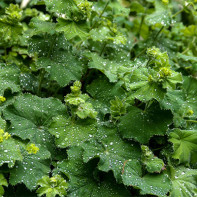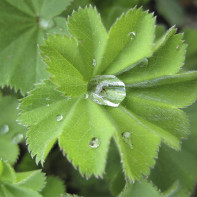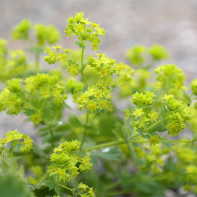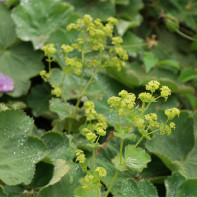Cuff: medicinal properties and contraindications
This herb has many names. In reference books, this is an ordinary cuff, but popular names are much more poetic - for example, love spell, god tear, heavenly dew or star grass. And in ancient times it was also called the grass of the alchemists. Indeed, this perennial herbaceous creeping plant has many useful properties. It has anti-inflammatory, expectorant and choleretic effects, has antiseptic properties, is able to stop blood flow. And although the cuff has not been officially recognized as a medicinal plant, it is widely used in industry for the production of dietary supplements.
- Chemical composition
- How it looks and where it grows
- Views
- Collection and storage
- The healing properties of grass cuffs
- For women
- For men
- During pregnancy
- For children
- When losing weight
- The use of cuffs in traditional medicine
- Types of healing compounds with a cuff
- Infusion
- Tincture
- Decoction
- Tea
- Application in cosmetology
- Contraindications
- Interesting Facts
Chemical composition
All the healing properties of the common cuff are well understood. All of them are explained by the chemical composition of its roots, grass and leaves. Some of the most important ingredients from a medical point of view include:
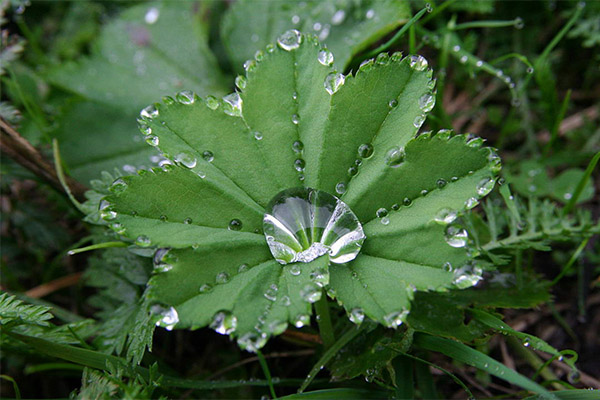
- Tannins are mainly tannins, most of them are found in the roots, in leaves and stems - only up to 3%.
- Catechins are flavonoids with antioxidant properties.
- Steroids are hormone-like substances of plant origin.
- Lignin - a positive effect on the microflora of the large intestine.
- Lecithin - used in the manufacture of hepatoprotectors, as it allows you to protect liver cells.
- Ascorbic acid (vitamin C) - beneficial for the circulatory system.
- Various macro and micronutrients, including zinc with its anti-inflammatory properties, boron and manganese.
Also, the plant includes oleic, phenolcarboxylic, linoleic and other acids, lipids, coumarins, glycosides.
How it looks and where it grows
In modern herbal medicine, the common cuff is most often used. This is a grassy undersized plant with relatively thin stems creeping on the ground. During the flowering period they rise a little. In height, the cuff grows to 30 cm.
The rhizome of the plant is quite powerful, located horizontally. Leaves at the roots grow large, slightly wavy. But the leaves on the stems differ in a semicircular shape. They are pubescent on both the front and the back, have serrated edges. In general, the shape of the leaves is interesting in itself. At the base, they seem to fold into a funnel, due to which they are able to retain precious moisture.
In addition, there are hydatodes at the edges of the leaves - these are specific glands, from which liquid is released in droplets, so the plant gets rid of excess moisture. Basically, such a process (guttation) is characteristic of tropical forests with their high humidity and low light. In a temperate climate, this feature is rare, and the cuff is one of its few examples.
Interestingly, the dense pubescence also protects the plant from waterlogging, because thanks to this, even after rain, the leaves remain almost completely dry.
The cuff blooms twice a year (under favorable conditions). For the first time this occurs in early summer, repeated flowering is possible in early autumn. Her flowers are small, light green in color, collected in narrow inflorescences that are more reminiscent of balls in shape (although in botany they are usually called corymbose-paniculate). Cuff fruits are formed in August.
Views
There are several varieties of cuffs, but not all of them are used in medicine. Some are bred mainly for decorative purposes. Widespread:
- The cuff is soft. This kind of plant is found both in Eastern Europe and in Asian countries - Turkey, Iran, etc. This is a fast-growing creeping plant with beautiful yellow inflorescences. It grows with curtains reaching a height of 40 cm - and their width is about the same. When openwork inflorescences appear on it, and this usually happens in June, such a bush looks very magnificent and spectacular. The soft cuff is used mainly in landscape design; in the garden it is often planted near ponds, in curbs and mixed flower beds. In floristry, it is included in bouquets to make floral arrangements more magnificent.
- The cuff is alpine. It is found in quite severe climatic conditions, in Greenland and Northern Europe. This variety is preferred by calcareous and rocky soils. This cuff differs from other types even externally. She has deeply dissected leaves, and from the inside they are covered with a very light silver fluff, which makes them seem to have a white frame. Thanks to this, the plant looks very decorative even outside the flowering period. It is used mainly in landscape design - it is planted in rockeries, container landings in the company with hyacinths and tulips also look spectacular.
- Red-cuffed cuff. This species is also often found in alpine meadows. In nature, it grows in the Crimea, in the Bulgarian Rhodopes, in the Caucasus and in the western part of the Carpathians. It differs from other varieties in very small sizes - in height it reaches no more than 15 cm. In addition, this cuff has a characteristic bluish-green hue of leaves attached to the stem with reddish petioles. This variety is also often used in landscape design, planting in rockeries. But such a cuff can look good in curb landings.
The listed species are mainly grown in gardens. But, in addition, in the middle zone of Russia there are many wild species. In total, there are more than 30 species of this plant. For example, in dry areas you can find mountain, bluish and spherical-twisted varieties. Also in arid areas, a tubercle cuff grows. In shady forests and in conditions of high humidity, lunate and wavelike varieties grow, and in wetlands - unstable.
There are also varieties that feel equally good on both dry and wet soils (for example, a bristled cuff). But still, the most common option is the ordinary cuff. And it is it that is used in traditional medicine and in the pharmaceutical industry.
Collection and storage
In herbal medicine, both the cuff grass and its rhizome are used. The aboveground part is harvested from the second half of May until mid-summer. You can collect grass only in the daytime, taking into account the above-described effect of guttation - you need to wait until the morning dew and the released moisture are dry.
Grass should be cut with leaves, shoots and flowers with a sharp knife. Dry this raw material in the shade, best of all - in a room with good ventilation. You can also use special dryers. However, in this case, you need to configure the most careful temperature regime - not higher than 60 degrees. Dried grass and flowers should be stored in paper or linen bags until next year, no longer, because over time the grass will have a very unpleasant bitter taste.
The roots of the cuff are also harvested for medical purposes. But it is recommended to dig them out already at the beginning of autumn. You do not need to wash them, just gently clean them from the ground. They are also dried in the attic. Such raw materials are stored in linen bags for no longer than 2 years. Like any other medicinal plants, the cuff is kept in a dry and dark cabinet, away from a heat source so that it does not deteriorate under the influence of sunlight and high temperatures.
The healing properties of grass cuffs
The unique chemical composition of this plant determined its healing properties. That is why the "grass of the alchemists", as the cuff was called in antiquity, acts in this way:
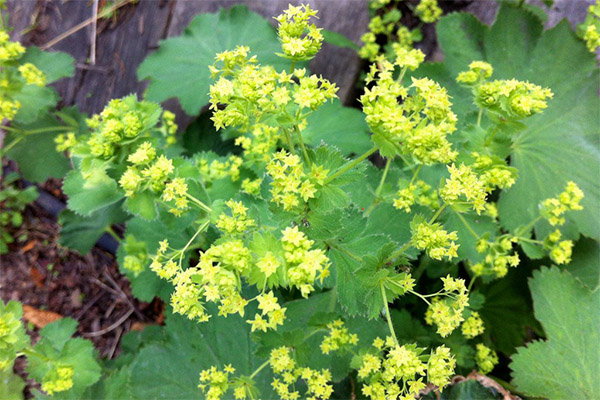
- Stimulates the production of progesterone - a female sex hormone. This is due to the high content of plant steroids. These properties have been confirmed by scientific research conducted in St. Petersburg. The ability to affect hormonal balance makes the cuff an effective remedy for dysmenorrhea.
- Regulates metabolic processes - also due to the content of steroids, lipids and a number of other substances.
- Normalizes the work of the cardiovascular system.
- Enhances the body's natural immune defense.
- It has antiviral activity - virologists have proven its effectiveness in the fight against influenza. This property is due to the action of flavonoids, which are strong antioxidants and also have anti-inflammatory effects.
- It has not only anti-inflammatory, but also anti-aging effect and removes toxins due to the presence of lignin in its composition.
- Accelerates tissue regeneration and heals burns and cuts due to the high content of coumarins.
An ordinary cuff is only called so, but in fact this grass is in many ways unique. Means based on it not only heal wounds and strengthen capillaries, but also accelerate the regeneration and are an effective prevention of heart attacks and a number of vascular diseases.
For women
For the fair sex, an ordinary cuff is useful in that it contains steroids. These are plant analogues of female sex hormones. At the same time, unlike synthetic agents used in hormone replacement therapy, infusions and decoctions of the cuff practically have no contraindications and side effects.
Mostly, cuff-based products are used for dysmenorrhea, that is, malfunctions of the menstrual cycle, but they can also be effective during menopause. And their anti-inflammatory properties make them an excellent remedy for many diseases of the pelvic organs.
For men
For the stronger sex, the anti-inflammatory properties of the cuff are also important, since agents based on this herb can be used in the treatment of prostatitis and urethritis. But much more important for them is the ability of the grass to strengthen blood vessels and regulate the level of "bad" cholesterol, since men are more at risk than cardiovascular diseases than women.
During pregnancy
In traditional medicine, it is believed that a decoction of the cuff herb or less concentrated tea from this plant should be drunk when there is a threat of miscarriage. Also, many herbalists recommend taking such drugs with severe toxicosis in the first trimester or with the occurrence of abdominal pain. However, you can drink such herbal decoctions only after consulting a doctor, especially since pain can be associated, for example, with an ectopic pregnancy.
In the old days, women in labor were given a decoction of the cuff just before childbirth to facilitate this process, but in modern conditions this is not encouraged in maternity hospitals, and there are also more effective medications.
The common cuff is also considered a good tool for lactation, many advise it to take young mothers trying to establish breastfeeding. But you need to be careful and first make sure that the child does not have an allergic reaction to such infusions and decoctions.
For children
Although the common cuff is considered a good anti-inflammatory and expectorant, it is not recommended to use it to treat young children. Some pediatricians believe that it should not be given to preschoolers at all, but to adolescents it can be useful for strengthening muscles and joints. In addition, teenage girls are given decoctions and infusions of cuffs in order to relieve menstrual pain and establish a cycle.
When losing weight
Steroids, lignin and lecithin are components that make the ordinary cuff effective for weight loss, as it helps to establish metabolism. In addition, phenolcarboxylic acid is part of this herb. It has unique properties - firstly, it has a warming effect, and secondly, it improves vascular permeability. Due to this, blood circulation is also enhanced and metabolic processes are accelerated, especially since the action of phenolcarboxylic acid is supported by the flavonoids and tannins that make up the plant. Among other things, they have a rejuvenating effect and allow you to make the skin smoother and firmer, so the cuff is also used to treat cellulite.
Tea based on this herb, which will be described below, is considered the most effective for weight loss. But from cellulite it is better to make compresses with a decoction of the cuff.
The use of cuffs in traditional medicine
Although there are more than five hundred varieties of this plant in nature, only an ordinary cuff can be useful for herbal medicine, but it is effective in a variety of pathologies:

- In case of inflammatory diseases of the uterus, it is recommended to drink a decoction of grass and leaves of the cuff - 0.5 l per day, dividing into three portions of equal volume. To improve the taste, you can add a little honey. This tool is also considered effective for restoring the uterus after a difficult birth.
- With amenorrhea (painful menstruation), it is recommended to drink 400 ml of decoction of the cuff per day, divided into two doses - in the morning and in the evening.
- For migraines and headaches provoked by high blood pressure, you can drink a cup of tea based on the cuff per day.
- For the treatment of purulent wounds and cuts, a cuff infusion is used, on the basis of which compresses and lotions are made.
- In some inflammatory diseases of the pelvic organs, the infusion or decoction of the cuff can be used for vaginal douching.
- In the treatment of hemorrhoids, the cuff is good for its complex effect. It stops blood, promotes tissue regeneration, strengthens blood vessels. For these purposes, an infusion of cuffs is used, with which special swabs are impregnated.
- With anemia and atherosclerosis, it is recommended to take a decoction of the leaves of this plant, which insist on grape wine. This remedy is considered effective for pain in the heart.
- In chronic colitis outside periods of exacerbation, it is recommended to take 10-15 drops of alcohol tincture of the cuff per day (diluting them with a small amount of water).
- With diabetes, it is recommended to take 200 ml of a decoction of the cuff per day. But only, unlike the treatment of other diseases, honey cannot be added here.
- When treating cut wounds, you can use fresh leaves, which are slightly rubbed in the hands so that they release juice. This green mass just needs to be applied to the damaged area of the skin.
The above cases, the use of the cuff is not limited. This plant can be used to remove sputum in bronchitis of various origins, in other diseases of the respiratory tract, including pneumonia. In addition, a decoction of the grass is used to rinse the mouth with stomatitis, lotions for conjunctivitis are made from it (if this disease is of bacterial origin, then the cuff is used in addition to antibiotic therapy, but not instead).
Types of healing compounds with a cuff
On the basis of this plant make means for both internal and external use. The most common option is water extraction of nutrients, that is, decoctions and infusions. However, some herbalists for the treatment of diabetes and obesity recommend taking powder from crushed plant materials.
As for funds for external use, it can be various compresses, poultices, applications. For them, not only infusions and decoctions are used, but also the juice of the cuff. It is squeezed from young leaves and shoots. Such a tool can be used to treat acne, diluting it with milk in a proportion of 1:10.Juice is also suitable for internal use - for example, it is drunk with diarrhea (every 2 hours for 1 tsp of the drug).
Infusion
This tool is prepared as follows - take 3 tsp. chopped herbs and leaves of the cuff and pour 250 ml of boiling water, and then leave for 2 hours under a closed lid. Then the infusion is filtered, the remaining plant material is squeezed out.
The resulting infusion is considered quite concentrated. It is used in the treatment of heavy menstruation, and also relieves inflammation in various purulent diseases. In the latter case, baths and poultices are made on its basis. Compresses with an infusion of the cuff alleviate the symptoms of varicose veins, although they do not completely eliminate its causes.
In some cases, the infusion is made less concentrated - take 3-5 tablespoons. raw materials per 1 liter of boiling water, bring to a boil and keep on low heat for another 10-15 minutes. Then insist for an hour. Such an herbal infusion can be drunk for weight loss, combining its intake with sports.
Tincture
Unlike many other tinctures, the cuff-based product is not made on alcohol, but on wine. For him, you need to take 1 tsp. dry crushed vegetable raw materials for 170 ml of wine. The drug is infused quickly - during the day (for this it is left in a dry and dark place). Before use, the finished tincture is filtered through two layers of gauze. Take it for atherosclerosis and other diseases.
Decoction
A decoction of the cuff is considered an excellent antiseptic. In addition, it has astringent and expectorant properties, and a number of studies have shown its sedative effect. Basically, it is taken orally. But thanks to its antiseptic properties, it can also be used as an external agent - for example, with acne.
To prepare a traditional broth, take 4 tsp. chopped herbs in 250 ml of boiling water, bring to a boil again and keep on fire for another 5 minutes. After this, the broth is left to cool, passed through gauze or filter paper and used as an internal or external agent.
Wine decoction is also prepared based on grass cuffs. Take 30 g of crushed dried stems and leaves per 1 liter of red wine and heated for 10 minutes. This tool is taken in 3-5 tbsp. the day before meals. It helps to get rid of diarrhea (provided that it is caused by dysbiosis or intestinal infection, if even after a month of such treatment its symptoms persist, you need to see a doctor).
A wine decoction is prepared from the root of the cuff. A glass of wine is taken per 20 g of dried plant material, this product is brought to a boil and left for another 30 minutes over medium heat. The finished broth is passed through several layers of gauze to get rid of pieces of root. There is another version of this recipe. A decoction of the root is prepared separately, taking a very small amount of water, after which they add wine and heat it, but do not boil in order to preserve all the useful substances to the maximum.
Such a tool can be taken in 2 tbsp. per day 30 minutes before a meal with anemia, it is also considered effective for dysbiosis and triggered flatulence. Nutritionists find this wine decoction a great way to break up metabolism.
Tea
Tea is also prepared on the basis of this plant - it is brewed in the same way as a traditional drink from tea leaves, that is, 1-2 tsp. crushed dry raw materials are poured with a glass of boiling water, insisted for 10-15 minutes, and then filtered. Tea is mainly taken as a restorative, in addition, it helps a lot from insomnia. Some herbalists recommend giving it to children for the prevention of rickets, but it’s better to consult a pediatrician after all, as modern doctors believe that in babies this remedy can cause allergies.
Application in cosmetology
Cuff is not in vain considered a "female" grass. It is useful not only for the treatment of diseases, but also for home beauty treatments. The powder from the dried leaves of this plant can be added to ready-made cosmetic masks and lotions, since it also has an antioxidant effect and allows you to stop premature skin aging.
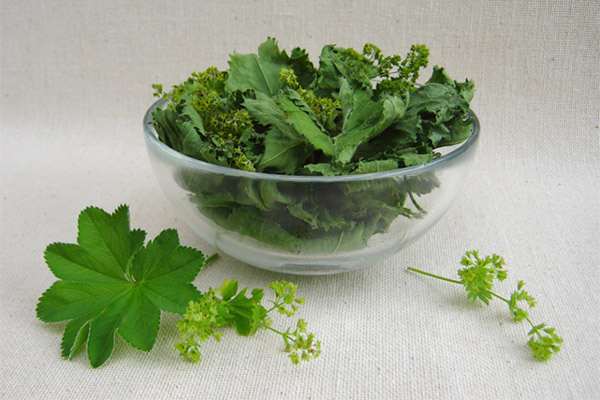
In home cosmetology, a decoction of the cuff is most often used. It is recommended to prepare it in the summer and freeze in ice molds. The resulting cubes are used to massage the face. This allows you to increase the elasticity of the skin, make it smoother, improve its oxygen supply by enhancing microcirculation.
With acne, the cuff infusion is most often used - as lotions or lotions. However, it is considered more effective ointment, which is prepared from alcohol tincture of the cuff (10-20 ml of the finished product - it is sold in pharmacies), mixed with petroleum jelly (up to 90 g). This ointment is considered effective for single acne and boils.
The cuff will also be useful for strengthening hair, because their condition directly depends on hormonal balance. You can add an infusion or decoction of this herb to the water prepared for rinsing the hair. And you can prepare a decoction based on the following plant harvest - for 15 g of dried grass, the cuffs take the same nettle grass and twice as much chopped dried burdock roots. All this is poured into 1 liter of water and brought to a boil, boiled for 5-7 minutes, then cooled and insisted for 45-60 minutes. The resulting product can be added to water to rinse the curls or rubbed into the scalp instead of lotion. Its regular use helps strengthen hair follicles.
In some recipes, birch leaves are added to this collection, this helps to make the remedy effective also against seborrhea.
Contraindications
One of the advantages of the cuff is that this herb has virtually no contraindications. It can not be taken only in the presence of allergic reactions and individual intolerance, as well as high blood coagulability. It is prescribed with caution during pregnancy and lactation - only after all studies and consultations with a doctor, since an overdose of even plant steroids can have a negative effect on the body.
Interesting Facts
- The cuff looks modest, but actually belongs to the illustrious family of Pinks. In botany, it is called Alchemilla, derived from the word "alchemy" - this is an ancient science whose followers were looking for a philosopher's stone and an elixir of eternal life. The healing properties of this herb were already known then, and ancient scholars believed that the ability of a plant to secrete liquid indicates its magical nature. The drops of morning dew that were collected in a natural funnel formed by leaf blades were especially valued.
- Practice has shown that the cuff actually has many useful properties and is able to get rid of a variety of pathologies, although of course there is no magic in this.
- The Russian name of this herb, which is actively used today, arose due to the similarity of the leaves of this plant with lush lace cuffs, fashionable in the gallant century. But in England and Germany, people saw in their form a resemblance to the mantle of the Virgin Mary, hence the name "mantle of the lady." In almost all countries of Western Europe, magical properties were attributed to this grass. For example, it was believed that the dew collected in the leaves helps to restore youth, and also eliminates acne, freckles and age spots.
- It is interesting that the cuff can also be used in cooking, usually for these purposes they take the leaves of the plant, sometimes young shoots. In early spring, this herb can be added to a salad of leafy greens, soup or green borsch. Sometimes it is harvested as seasoning. To do this, it is dried in the manner described above, since it allows you to save almost all useful substances, and in winter it can be added to both soups and main dishes. And it’s also a useful vitamin supplement, since it contains a large amount of ascorbic acid. In oriental cuisine, leaves can be salted along with other herbs or vegetables.
«Important: all information on the site is provided exclusively in fact-finding purposes. Before applying any recommendations, consult with a profile specialist. Neither the editors nor the authors are liable for any possible harm caused materials. "

